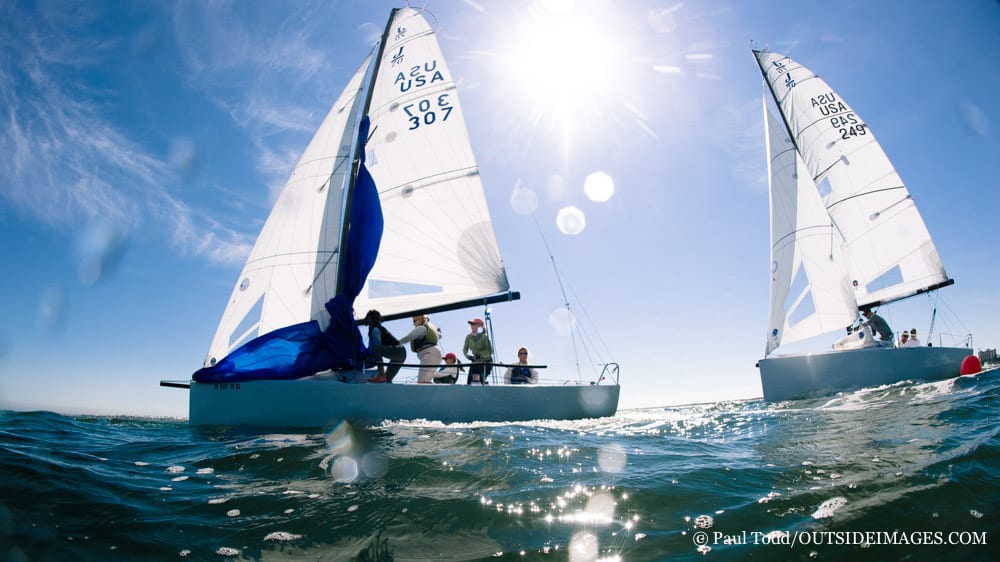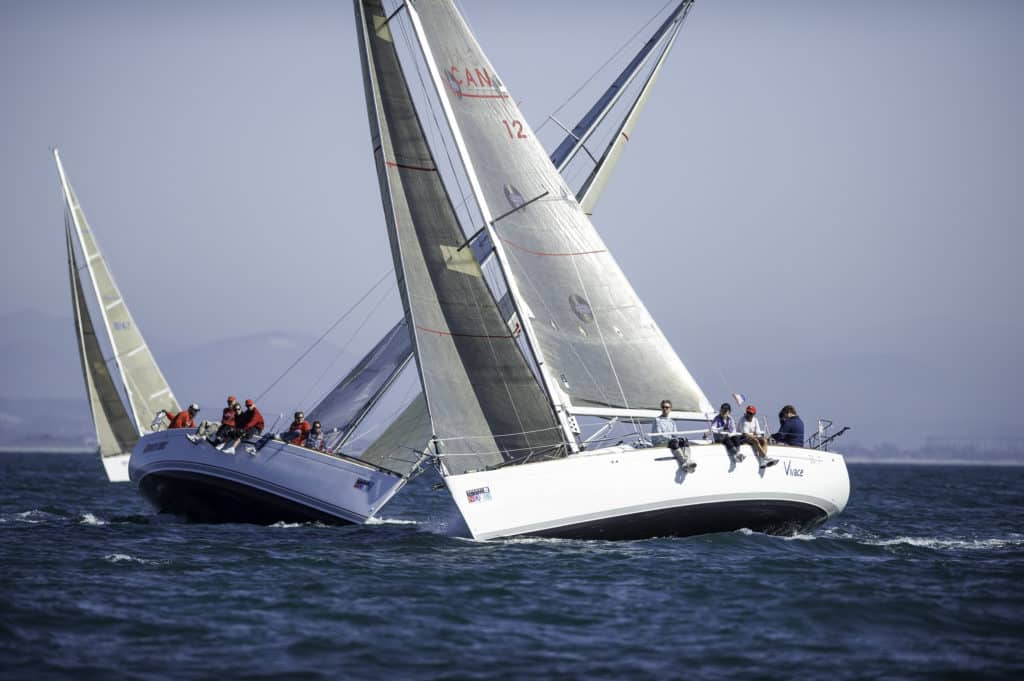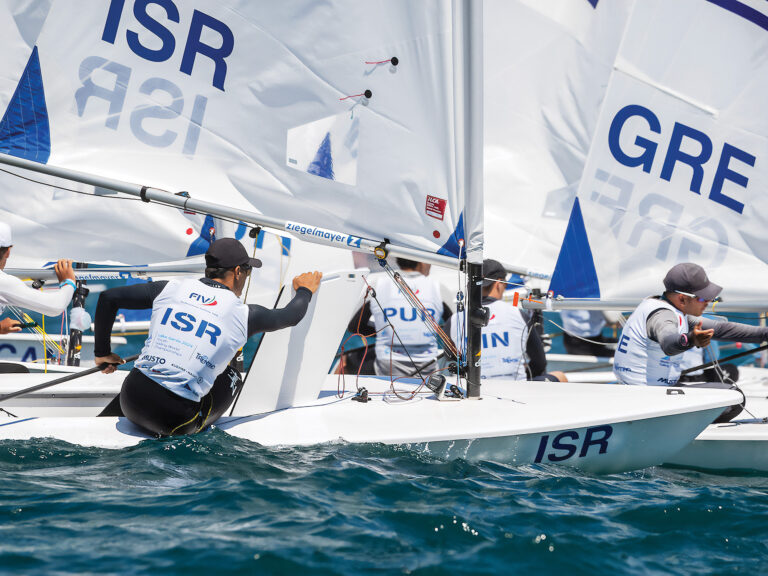
Most athletes have their preferred method of preparing for events. Some practice in groups or as a team, or tune up with a friend or competitor. Others prepare by themselves. Sailors are likely to use any one of these methods at some point, depending on what they’re working on. Boathandling, for example, is best improved alone. Tactics are best honed within a group of boats. The best way to improve boatspeed is to practice with two boats sailing close together, experimenting with virtually every variable affecting speed. If two teams work together in an organized fashion, they can quickly step up one another’s performance. Someone once said, “If I can speed up two boats so they’re faster than anyone else, then there’s only one boat I have to beat.” He was absolutely right.
The essentials of two-boat tuning are simple: set up a pair of boats so they’re as closely matched in speed as possible. Keep one boat as the “control” boat and experiment one at a time with speed related variables on the other.
When setting up a two-boat session, establish exactly what you’re trying to achieve. Perhaps you want to know how much faster your new sails are, or what effect mast rake, shroud tension, jib-lead angle, etc., have on your speed. The more specific the focus, the better the results.
Another major consideration is the selection of a training partner. The two teams should share similar goals and have a similar desire to achieve them. Both should be roughly at the same competency level. Be careful about selecting a rival for a partner. This often leads to boat-on-boat combat where the goal is beating the other boat, which defeats the intent of advancing both boats together.
Advance planning is a must. Everyone involved must know the test variables, and the order in which they will be worked on. Start with more general items and work toward smaller, more specific adjustments. With a one-design class, for example, mast rake, rig tension, and mainsheet tension are good general tests. Jib-lead positions, cunningham, outhaul tension, etc., are fine-tune variables.
When deciding which variables to test, consider the conditions. In light air and choppy seas, for example, you can experiment with mainsail twist or heel angle, but if the sea breeze fills, you can try different jib leads and inhauler adjustments. Don’t try more than one variable at a time or you won’t be able to tell which one (if any) is making a difference. Give new adjustments time, and give yourself and your crew time to make critical observations.
Make the boats even
Before testing begins, the variables to be tested should be scaled on each boat. Identical decals with numbered markings are ideal and make duplicating and comparing settings much easier. This is the base on which two-boat speed testing is built, because it allows the effect of a tuning change on the non-control boat to be compared precisely.
If they are identically equipped, then the decal scales and other measurements (taken with a Loos gauge, or Harken’s Rigtune Pro, for example) can be used to set up the boats similarly before sailing. If the boats are different (different sails, spars, etc.), then each skipper should start with their standard tuning.
In either case, begin sailing upwind with the boats positioned about two boatlengths apart, their bows even. This bow-even position makes it easy to measure gain and loss, and discourages the leeward boat from trying to pinch off the weather boat. The pair must remain two boatlengths apart to reduce the possibility of the windward boat blanketing the leeward in a lift, or of the leeward one gaining a safe leeward position in a header.
If it’s apparent the boats aren’t even, stop and figure out how to speed up the slower boat. It’s not uncommon to spend a lot of time getting the boats even.
If one boat seems faster than the other no matter how hard the slower boat works at stepping up its speed, switch skippers to determine if the slower skipper is “off.” If the boats remain uneven, or the crews vary in weight, experience, etc., then consider rotating individual crewmembers as well.
Once the boats are fairly even in speed, it’s time to hone in on the pre-determined variables. Sail upwind in the bows-even position, continuing until one boat has gained a one-boatlength advantage. The faster boat should then luff and reset into the bows-even position to start again. Some sailors time their test runs for 3 minutes, stop, discuss, and then line up again.
This routine should be run three or four times to be sure one boat is actually faster and not just hitting fewer waves, gaining in a persistent wind shift, or just plain being steered better. After the fourth time a significant advantage has been gained, switch windward/leeward positions and resume the testing.
If the same boat is faster still, the trim adjustment or equipment change being tested should be implemented on the other boat. If the relative speed between the two boats changes, then the effect of that variable is isolated.

Share what you learn
Communication between boats throughout this process-two-way radios are ideal-is important for keeping the session flowing. Crews should constantly be feeding their skippers information about how they’re pointing (higher or lower) and moving (faster or slower) relative to the other boat.
A coach boat following the two teams can also be a huge benefit to the entire process. A coach can be an extra set of eyes in determining subtle differences between the boat set-ups. Digital pictures add to the post-test debrief, where different set-ups can be viewed alongside one another. Video adds one more tool as steering and weight movements can truly be compared-often these areas provide the biggest differences in speed.
It’s always important to watch the compass while two-boat testing. A 10-degree shift can mean a half-boatlength gain. These shifts should be communicated from boat to boat so everyone is aware.
After sailing upwind for a while, take a break and compare notes. These talks mean a lot to the overall outcome because all adjustments are freshly in mind. Assign a secretary to take notes about everyone’s settings. Be sure to record the conditions in which the testing was done, and also how the faster boat moved-whether it was pointing higher, footing, showing more punch through the waves, etc.
Downwind sessions, too
Half the race is sailed downwind, so excellent speed and depth is a must. Off-the-wind technique seems to be more important than upwind technique, where tuning is a priority, so two-boat speed testing should be focused accordingly.
Start with general variables such as weight placement, steering technique, sheet trim, board height, etc., and move to finer adjustments such as outhaul tension, spinnaker pole height, distance of spinnaker off the mast, etc.
If you’re practicing on a reach, position the second boat one boatlength behind the first. This gives both boats clear air and makes it easy to note speed differences. If running or broad reaching, line the boats up bow-to-bow and two boatlengths apart. Be sure to follow a constant compass reading as a reference point to steer by. As two boats sail alongside each other, the slower one will often unconsciously steer higher to build speed. The other boat usually follows and soon you have an inadvertent luffing match.
The all-important review
After a two-boat session, both teams (plus a coach, if there is one) should sit down and review their findings. All the conditions should be written alongside the combinations found to be fastest. Don’t be surprised if there are overlaps or even contradictions-just keep track of the different “tunes” that produced similar results and test them next time. After doing this in various conditions, you’ll be able to augment your sailmaker’s tuning guide. While racing you’ll spend less time determining the fastest trim, and more can be devoted to thinking about tactics.
A proper session of two-boat testing takes a lot of time. However, with the proper advance planning, it can be done in bits and pieces. If you and a friend organize the time that you do have to practice, even if it’s just a few weekday evenings or on the way out to the starting line, you will accelerate each team’s performance.
Ace the Two Boat Test
Two-boat testing can be a challenge, but nothing else is as productive. Remember:
1. Select the proper partner: Find someone who shares your goals, skill level, and committment. Having the same sails and equipment is also handy.
2. Even out the boats: Take the time to make the boats as identical as possible. Check rig tensions and mark anything that will be changed.
3. Be diligent: One test is never conclusive. Test and retest to be sure. Record all your results, even if they conflict.
4. Share: Withholding any information will only hurt both teams.









